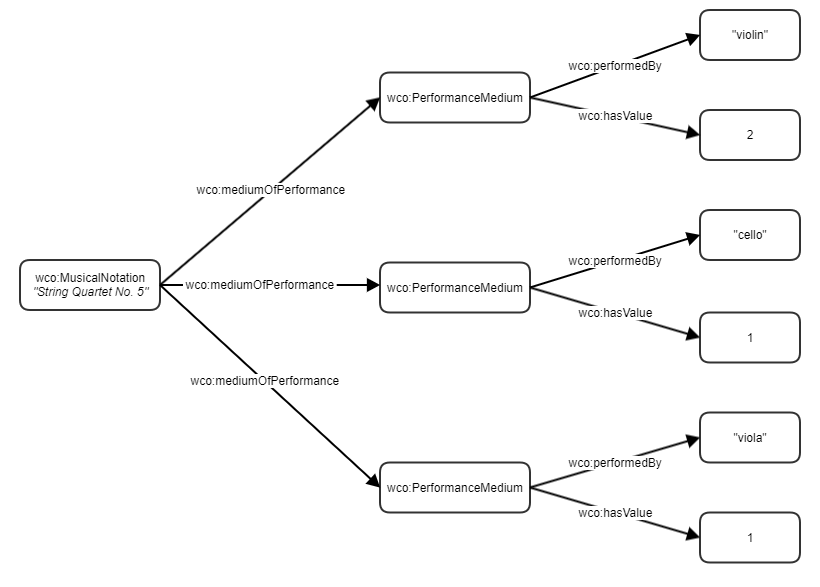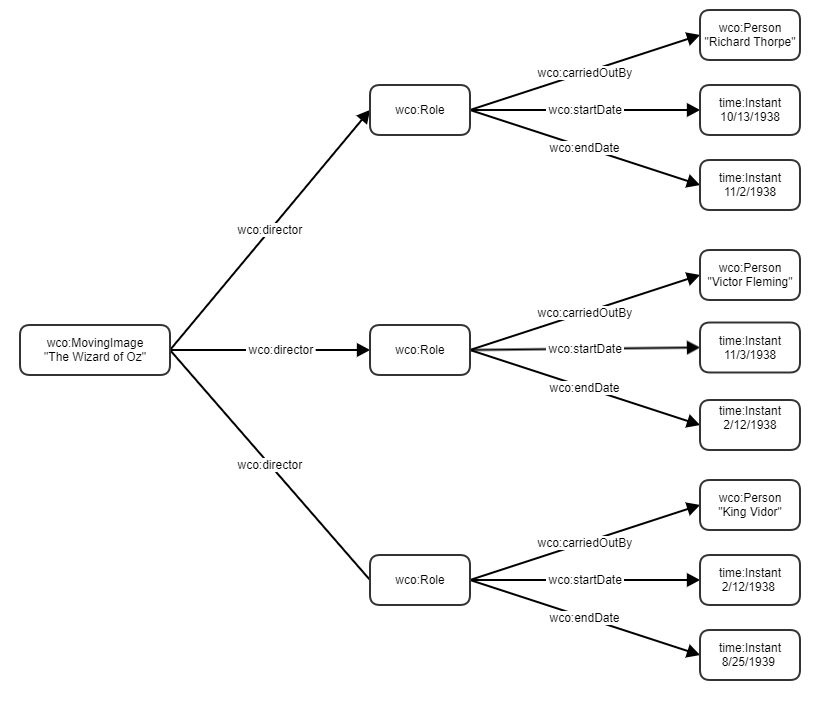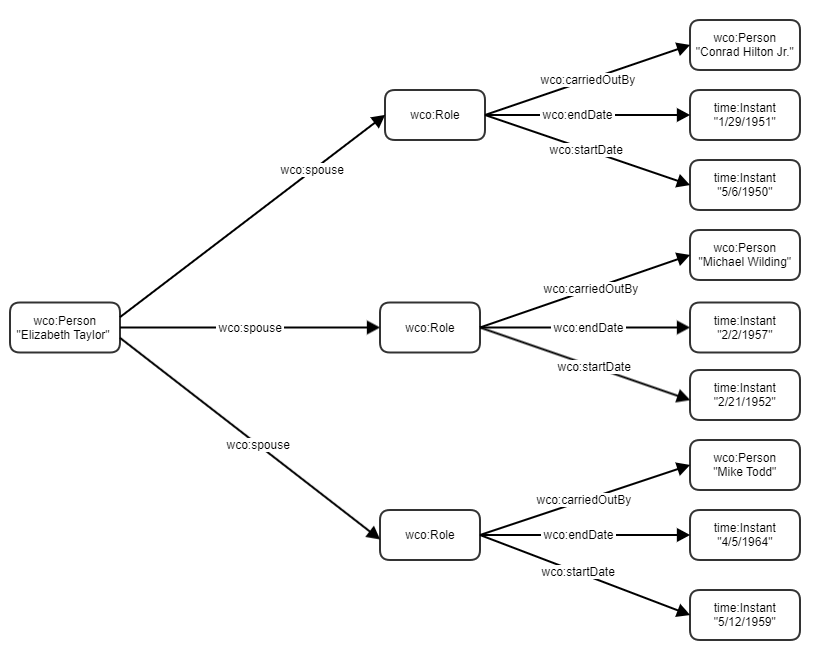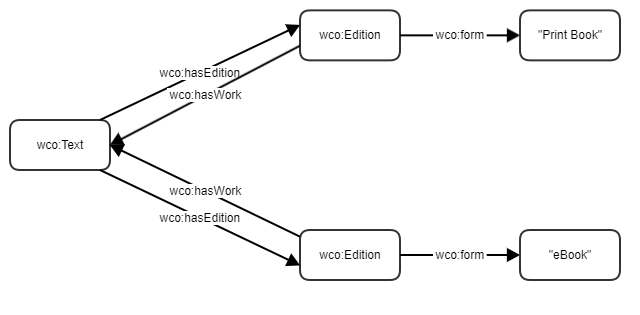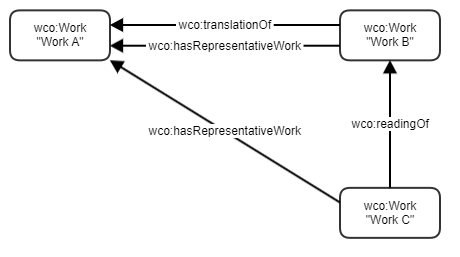WorldCat ontology primer
1. Introduction
1.1 Document Scope
This document is a primer. It is intended to provide an overview of the structure, purpose, and scope of the WorldCat ontology.
1.2 Entity Types
The WorldCat ontology is designed to provide a framework for expressing interrelationships between authority entities. Entity types represented by the ontology include, at a high level:
- wco:Agent
- skos:Concept
- wco:Edition
- wco:Event
- wco:Place
- wco:Work
Each entity type will be addressed in more detail later in this document.
1.3 Purpose and key principles
The WorldCat ontology focuses on the ability to add authority entities (persons, places, events, etc.) which complement the robust bibliographic descriptions of BIBFRAME entities. By describing the relationships between and among bibliographic and contextualizing authority entities, the WorldCat ontology removes data silos that separate traditional bibliographic and authority data in libraries. The WorldCat ontology is intended to bridge the gap between cataloging and general-use data by providing a broad model for knowledge work. Resource access is improved through meaningful relationships which allow users to seamlessly traverse across data types and open new opportunities for data reuse, such as serendipitous discovery.
1.4 Diversity, Equity, and Inclusion (DEI)
OCLC values include an ongoing commitment to supporting diversity and inclusivity. Reflecting these values, OCLC invested significant effort in seeking external perspectives prior to release of the WorldCat ontology. This resulted in revisions to labels and descriptions, and added to our understanding of how the ontology can be more inclusive and support a range of world views and experiences.
1.4.1 The ontology reflects the state of our field
OCLC has invested in structuring the ontology and using language to support a more inclusive range of experiences and worldviews. However, there is a tension between inclusive description and the legacy of knowledge systems and data that reflect Western-centric worldviews that, at times, uphold racist and colonialist viewpoints. To scaffold a transition toward a more inclusive future, it may be necessary to diverge from legacy practices. As the WorldCat ontology matures, additional scope notes will be provided that guide inclusive descriptions of WorldCat Entities. The WorldCat ontology properties, labels, and definitions should not confer legitimacy on acts of enslavement, violence, theft, and other injustices; nor fail to recognize the harms they caused. The information recorded in properties is not intended to confer legitimacy among conflicting claims of ownership or creation.
1.4.2 Properties related to Person entities
WorldCat Entities is an authoritative, but not biographical, resource. In keeping with the values and practices of the library cataloging community, properties which describe sex, gender, religion, race, ethnicity, sexual orientation, national identity, and/or citizenship status have been purposefully omitted from the WorldCat ontology. Properties which convey places of birth, death, and/or residence are intended only as statements of fact, not as an expression of national identity or citizenship status. Properties that describe common agent roles use gender-inclusive terms to the greatest extent possible. In some cases, these property labels may reflect terms which have become more gender-neutral in common usage.
1.4.3 Enslaved persons
Inspired by the work of the Enslaved project, special consideration has been given to properties that make statements about enslaved persons. It is morally and semantically incorrect to model the exchange of human lives using the same concepts that apply to the buying and selling of Works, Places, and Organizations. To avoid misinterpretation, the ontology distinctly defines wco:enslaved and wco:enslavedBy to represent these relationships in contexts where it may be the only record available for the entities involved. Any data in WorldCat Entities regarding enslaved persons is included to recognize and recover their contributions within the bibliographic universe.
1.4.4 This work is ongoing
OCLC has sought community consultation in creating and revising the WorldCat ontology but this work is ongoing. We invite feedback that will help us continue to improve our language and structures by sending an email to askqc@oclc.org.
2. Model constructs
2.1 Namespace and prefix
Base URI pattern: https://id.oclc.org/worldcat/ontology/
Prefix: wco
2.2 Common vocabulary elements
WorldCat ontology uses common linked data vocabularies as its fundamental building blocks.
OWL
The root class of the ontology is owl:Thing. All ontology classes are subclasses of owl:Thing. The following OWL classes are used to define ontological elements:
- owl:Class
- owl:ObjectProperty
- owl:DataTypeProperty
- owl:equivalentClass
- owl:sameAs
RDFS
The following rdfs properties are used to describe relationships between ontological elements:
- rdfs:label
- rdfs:domain
- rdfs:range
- rdfs:subclassOf
- rdfs:Resource is used as an object class.
RDF
- rdf:type is used to describe the entity type of instance data
SKOS
The following skos properties are used in the ontology:
- skos:prefLabel
- skos:altLabel
SHACL
The following SHACL (Shapes Constraint Language) properties are used to define constraints in the ontology:
- sh:minCount
- sh:maxCount
- sh:class
2.3 Time
The WorldCat ontology uses the OWL time ontology: https://www.w3.org/TR/owl-time/. Using an established and well-developed ontology which can extend the WorldCat ontology is more prudent than developing a bespoke model. The OWL time ontology allows for a breadth of descriptive time attributes including singular time instances, time ranges, and precision variables which express temporal durations such as decades or centuries.
2.4 How to read diagrams
Diagrams are presented where visualization is useful to explain abstract graph constructs. They should be regarded as illustrative only. In general, diagrams should be read left-to-right, with the left-most entity node indicating the subject of a rdf triple. Predicates (properties) are indicated with an arrow pointing to the entity node which is the object of the rdf triple. Property arrows are labeled with the name of the property in camel case. Curly brackets { } represent instances where the specific property varies based on the circumstance. For example, {agent role} acts as a stand-in for numerous potential agent roles (see diagram 3.2.5.1a).
3. Entity Types
3.1 Agent
Agents are entities capable of performing actions. The wco:Agent class includes three subclasses: wco:Family, wco:Organization and wco:Person.
3.2 Concept
The WorldCat ontology uses the SKOS Concept model with custom subclasses that extend SKOS to meet functional requirements of the ontology. Each extension is a subclass of SKOS Concept. The following sections detail each individually.
3.2.1 Frequency
The wco:Frequency class is intended to take the form of a blank node to which multiple descriptive properties may be attached. For example, a wco:ContinuingResource may have multiple frequencies during its publication lifespan. The blank node construct allows for multiple frequencies to be applied, with applicable start and end dates.
3.2.2 Measurement
The wco:Measurement class is a blank node intended to aggregate two required elements: a measurement’s value and unit. The wco:hasValue property includes SHACL constraints sh:minCount 1 and sh:maxCount 1 which require a single integer value. Each wco:Measurement node should include a wco:unit to be comprehensible. The only case in which a unit is not required is with the wco:population property, for which the unit of “persons” may be inferred. wco:Measurement nodes may also include wco:startDate and wco:endDate properties, to allow for recording changes in measurements over time.
Properties with expected value of wco:Measurement:
- wco:spatialArea
- wco:population
- wco:duration
- wco:elevation
Note that properties such as wco:dimensions and wco:extent are defined as datatype properties, which expect a literal value as an object. This is to accommodate significant variance in cataloging practices.
3.2.3 Performance Medium
The wco:PerformanceMedium class is designed to provide structured meaning to describe both the type and quantity of instrumentation required for musical works. This structure can be applied to instances of wco:Music (i.e., performances captured as sound) and wco:NotatedMusic (i.e., those intended to be studied or performed). Note that instrumentation in this context also includes the concept of vocalization(s).
The basic structure shows:
- A wco:Music or wco:NotatedMusic entity is linked to the wco:PerformanceMedium node.
- wco:PerformanceMedium is a blank node which fulfills the functional purpose of describing the “what” and the “how many” required for a performance.
- wco:PerformanceMedium requires two properties:
- wco:performedBy links to a skos:Concept which describes what is required for the performance. The use of skos:Concept facilitates linking to external vocabularies.
- wco:hasValue is an integer which describes how many of the “what” are required for the performance.
3.2.4 Postal Address
The wco:PostalAddress class is intended to take the form of a blank node which provides a common connection for the separate data elements common in postal addresses. It acts as an aggregation mechanism intended to allow the presentation of those elements as a coherent whole. The expected range of wco:addressCountry, wco:addressRegion, and wco:addressLocality are all wco:AdministrativeArea, which is designed to provide flexibility to account for variations in administrative organizations globally. While not enforced, the user is encouraged to regard wco:addressCountry, wco:addressRegion, and wco:addressLocality as an ordered hierarchy wherein:
- wco:addressCountry represents the largest wco:AdministrativeArea within which a wco:PostalAddress exists (e.g., a nation, kingdom, or other sovereign state).
- wco:addressRegion represents a subdivision of the wco:AdministrativeArea indicated by wco:addressCountry (e.g., a state, province, or territory).
- wco:addressLocality represents a subdivision of the wco:AdministrativeArea indicated by addressRegion (e.g., a city, town, or village).
3.2.5 Role
3.2.5.1 Work and Agent relationships
Instead of linking a wco:Work type entity directly to an instance of wco:Agent, a wco:Role node is added between them. This approach provides flexibility to describe:
- Complex relationships regarding wco:Pseudonym entities.
- Performative works in which a wco:Agent plays a fictional character.
- Instances of wco:Work in which multiple agents perform the same role at different times.
- Specific types of roles which do not have a dedicated property.
3.2.5.2 Role(s) in a performance
An instance of wco:Role may be used to indirectly link a wco:Agent to a wco:FictionalEntity that they portray in a performative work, such as wco:MovingImage or wco:Sound. Note that wco:Agent is also an acceptable range for the character property to accommodate works which include real-world entities in the performance.
This model can be expanded to accommodate any number of roles and characters necessary to fully describe the wco:Work. Note the utility here is the ability to add contextualizing information. In this example, we can see that Timothy Dalton was not only an actor in The Living Daylights, but that the character he played was James Bond. James Bond, as a wco:FictionalEntity, also exists as a graph entity, and therefore can also have properties applied to it. Those include properties that speak to the "work-ness" of James Bond, such as a wco:creator or wco:creationDate, as well as other actors who played James Bond and what films they played him in.
3.2.5.3 Multiple creators with the same role applied to a single work
The wco:Role entity type can be related to time instances which express how multiple individuals succeeded one another in the same role, when their tenure began and ended, and by inference, how long they occupied that role. In this way, the ontology can capture complex chronologies and convey not just the "who" but also the "when" for agents related to an instance of a wco:Work.
3.2.5.4 Interpersonal relationships
The wco:Role class is also implemented in limited cases as the common link between two wco:Person entities. Interpersonal relationship properties that utilize the wco:Role class are:
- wco:spouse
- wco:studentOf
The reason that these relationships utilize a wco:Role type node is that they conceptually include the possibility of multiple temporally defined relationships related to a given wco:Person entity. The temporal bounding of these relationships with wco:startDate and wco:endDate properties is therefore a significant factor in this modeling choice. Additionally, the use of the wco:Role class allows for addition of more specific relationships via the wco:typeDetail property.
By contrast, relationships such as wco:parent, wco:child, and wco:sibling tend to be regarded as more persistent and therefore most often do not benefit from temporal bounding, so they are modeled as direct person-to-person relationships to keep their structures as simple as possible.
3.3 Edition
wco:Edition entities represent the physical or digital manifestation of a wco:Work. They are conceptually aligned with a BIBFRAME Instance and LRM Manifestation. wco:Edition is not a hierarchically inferior class (i.e., not a rdfs:subclassOf) of wco:Work. Both wco:Work and wco:Edition are direct subclasses of OWL Thing. wco:Edition and wco:Work entities represent a decoupling of the concept of a creative endeavor with the physical or digital manifestation(s) of it. However, they are logically interdependent in that the resource cannot exist without the idea of that resource, and an idea which takes no form is not a resource.
Multiple wco:Edition entities may be associated with the same wco:Work as each wco:Edition represents a variant format of the same essential content as described by the wco:Work entity.
3.4 Event
3.4.1 Transactional Events
The wco:TransactionalEvent class is utilized with properties that imply a transactional or transformative context. The wco:TransactionalEvent class is designed to supply data that is specifically and uniquely relevant to the event of the transaction, such as a wco:date, wco:relatedPlace, or wco:relatedAgent.
The entities engaged in the transaction are thereby related indirectly via a wco:TransactionalEvent node to which each entity is connected by a property that expresses the nature of the transaction. Those properties are listed in table 3.4.1 with their respective domain(s). The range of each property is wco:TransactionalEvent.
The model also requires using the wco:resultedIn and wco:resultedFrom properties which express a comprehensible, linear origination and outcome of the transaction. Diagram A illustrates:
- Entity A was succeeded by Entity B.
- Entity B was preceded by Entity A.
- A wco:TransactionalEvent occurred which resulted in Entity B.
- The same wco:TransactionalEvent resulted from Entity A.
- A linear, unidirectional path can be traced from Entity A (the predecessor) to the wco:TransactionalEvent and then to Entity B (the successor), which constructs a comprehensible and chronological chain of events.
- A linear, unidirectional path can be traced from Entity B (the successor) to the Transactional Event and then to Entity A (the predecessor), which constructs a comprehensible and chronological chain of events.
The model can be expanded to express more complex transactions. Diagram 3.4.1b illustrates the merger of two organizations.
- Organization A and Organization B merged to form Organization C.
- Organization C represents the merger of both Organization A and Organization B.
- The merger of Organization A and Organization B resulted in the creation of Organization C.
| property | domain |
|---|---|
|
owl: Thing |
|
wco:Agent |
|
wco:Person OR wco:Family |
|
wco:Organization OR wco:Place |
|
wco:Work |
3.5 Place
wco:Place type entities represent terrestrial or non-terrestrial locations. wco:Place entities are divided between two subclasses: wco:Landform and wco:AdministrativeArea. Note that wco:AdministrativeArea is a subclass of both wco:Place and wco:Organization since its definition implies both geographic fixity (i.e., "place-ness") as well as governance (i.e., "organization-ness"). It is both logical and practical to make these characteristics inseparable. For example, separating "The City of New York" into two discrete entities, one describing its existence as an urban administration and one as a geographic location would be impractical for metadata creators and confusing to end users.
3.6 Work
The term WorldCat Work is purposefully emphasized here to distinguish it from an LRM or BIBFRAME Work. WorldCat Works (wco:Work) are designed to include specific properties that are useful for end-user discovery, such as a particular language or type (text, image, sound, etc.). The properties applied to wco:Work entities are those which are applicable regardless of any physical or digital manifestation the wco:Work may take as a wco:Edition entity. They represent the core facts which describe the concept of a creative endeavor.
3.6.1 Fictional entities
The WorldCat ontology includes wco:FictionalEntity as a subclass of wco:Work. In this way, fictional entities inherit properties which can represent their “work-ness” such as wco:creator or wco:creationDate. Any entity may be multi-classed as both an instance of wco:FictionalEntity and any other class. For example, a fictional place would be declared as an instance of both wco:Place and wco:FictionalEntity.
3.6.2 Representative work
The WorldCat ontology does not utilize the LRM notion of a “Work” as a mechanism for grouping like entities. Instead, the idea of a "Representative WorldCat Work" is proposed to act as a common connection that fulfills the purpose of aggregation. The "Representative WorldCat Work" is currently defined as the first instantiation of a WorldCat Work or that which is considered the canonical resource. Note that the "Representative WorldCat Work" is not a class type. The "representative" Work is identified by derivative Works using the wco:hasRepresentativeWork property in addition to the property which expresses a transformative relationship between the works.
Expanding on this diagram, "Work C" is added below showing that it is a wco:readingOf Work B, and that Work A is the wco:representativeWork of Work C. In this way, the model can express how derivative works relate to one another while still directly relating them back to the "representative" Work.
4. Glossary
Blank node: A node without a persistent URI.
Class: A type of thing. A class may be tangible (Person, Place), or intangible (Concept). Classes form the basic categorical structure of the model. WorldCat ontology uses the owl:Class declaration.
Data type property: The property expects a literal, integer, or other text string. WorldCat ontology uses the owl:DataTypeProperty declaration.
Declared property: A property applied specifically to a given class. i.e., not inherited from a hierarchically superior class.
Domain: The class type to which a property is applied. WorldCat ontology uses the rdfs:domain declaration.
Entity: Entities are unique instances of things. They are not part of the ontology model but represent the individual instantiations of ontological elements. Each entity is defined by a Class and assigned a URI.
Graph: A “web” of discrete entities interconnected by properties.
Has subclass: The hierarchically inferior class of a given class.
Inherited Property: A property applied to a hierarchically superior class which is automatically applied to all subclasses.
Node: A data element in a graph. A node may be an entity, literal, or blank node.
Object: The "thing" to which a property connects. The object may be an entity or a literal value.
Object property: The property expects an entity defined by a class. WorldCat ontology uses the owl:ObjectProperty declaration.
Ontology element: Refers to any aspect or individual piece of the model. Classes, properties, and property shapes are all examples of ontology elements.
Prefix: An acronym used to denote a URI pattern. Prefixes are used in linked data serializations, such as Turtle, to produce compact documents. WorldCat ontology use the prefix "wco" to denote the base URI pattern <https://id.oclc.org/worldcat/ontology/>. Therefore "wco:Work" may be inferred as <https://id.oclc.org/worldcat/ontology/Work>.
Property: A relationship between things. Properties are the "connectors" which inform the meaning and structure of how entities relate to one another.
Property shape: The rule set applied to a property in a particular context. WorldCat ontology uses the sh:PropertyShape declaration.
Property type: Defines the type of property as determined by the type of expected object. WorldCat ontology uses owl:ObjectProperty and owl:DatatypeProperty
Range: The class type to which a property may connect, i.e. the valid class type. WorldCat ontology uses the rdfs:range declaration.
Subclass of: The categorically superior class of a given class. WorldCat ontology uses the rdfs:subClassOf declaration.
URI: Universal Resource Identifier. This is a unique persistent identifier to a resource. URI is not synonymous with URL (Universal Resource Locator) though the terms are sometimes used interchangeably. A URI is simply an identifier, not necessarily a web address. WorldCat ontology URIs resolve to web addresses, and therefore are both URIs and URLs.
5. Default namespaces
bf: <http://id.loc.gov/ontologies/bibframe/>
dash: <http://datashapes.org/dash#>
dc: <http://purl.org/dc/elements/1.1/>
dcmitype: <http://purl.org/dc/dcmitype/>
dct: <http://purl.org/dc/terms/>
dcterms: <http://purl.org/dc/terms/>
dnb: <https://d-nb.info/standards/elementset/gnd#>
edg: <http://edg.topbraid.solutions/model/>
graphql: <http://datashapes.org/graphql#>
madsrdf: <http://www.loc.gov/mads/rdf/v1#>
metadata: <http://topbraid.org/metadata#>
owl: <http://www.w3.org/2002/07/owl#>
rdf: <http://www.w3.org/1999/02/22-rdf-syntax-ns#>
rdfs: <http://www.w3.org/2000/01/rdf-schema#>
schema: <https://schema.org/>
sh: <http://www.w3.org/ns/shacl#>
skos: <http://www.w3.org/2004/02/skos/core#>
skosxl: <http://www.w3.org/2008/05/skos-xl#>
teamwork: <http://topbraid.org/teamwork#>
time: <http://www.w3.org/2006/time#>
wco: <https://id.oclc.org/worldcat/ontology/>
wd: <http://www.wikidata.org/entity/>
wdt: <http://www.wikidata.org/prop/direct/>
xsd: http://www.w3.org/2001/XMLSchema#
6. Acknowledgements
OCLC acknowledges the efforts of all the people who participated in producing this documentation:
Becky Dean, Anne LaVictoire, Charlene Morrison, Jeff Mixter, Morgan Peters, Michael Phillips, Merrilee Proffitt, Mercy Procaccini, Richard Urban, Anne Washington
The WorldCat ontology is made available under a Creative Commons Attribution No Derivatives 4.0 International license.
OWL Copyright © 2012 World Wide Web Consortium. https://www.w3.org/copyright/document-license-2023/
RDFS & RDF Copyright © 2014 World Wide Web Consortium. https://www.w3.org/copyright/document-license-2023/
SHACL Copyright © 2017 World Wide Web Consortium. https://www.w3.org/copyright/document-license-2023/
SKOS Copyright © 2009 World Wide Web Consortium. https://www.w3.org/copyright/document-license-2023/








